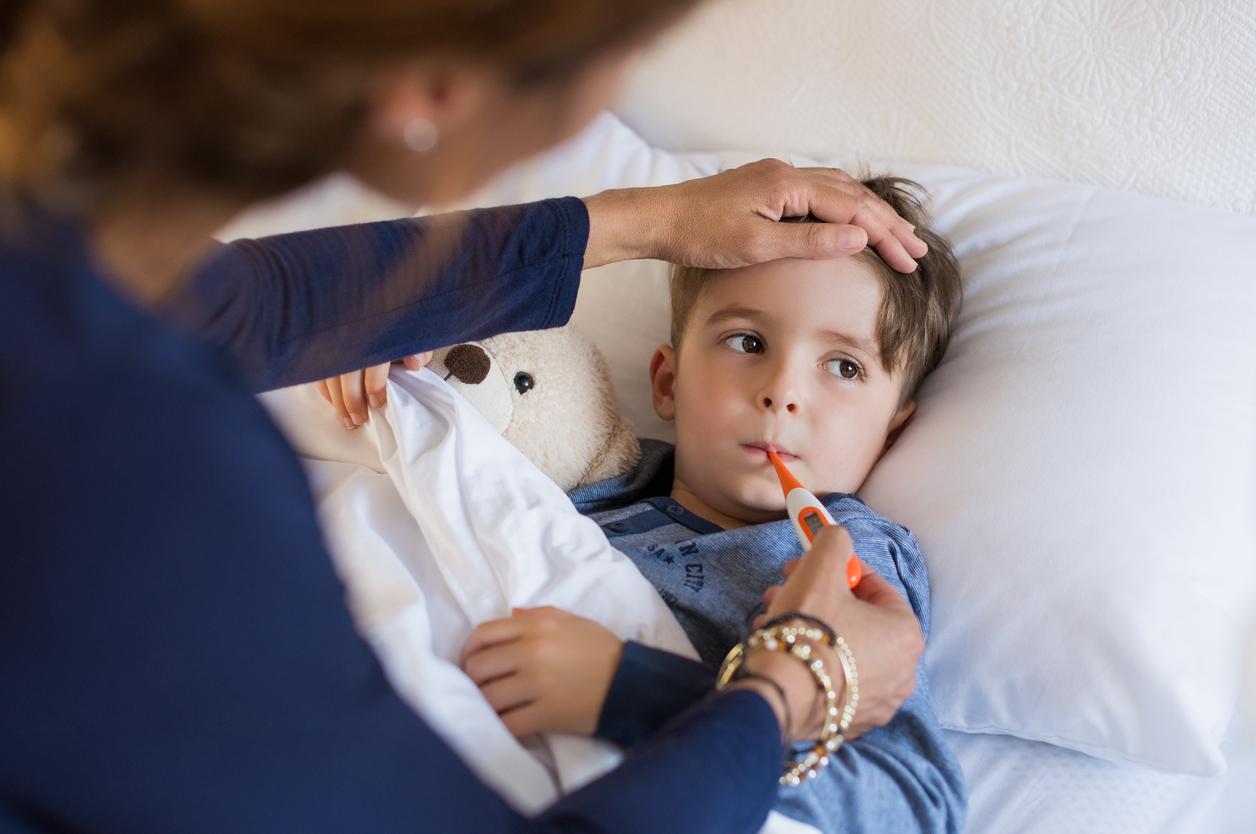- What is scarlet fever?
- Scarlet fever: what are the symptoms?
- Can adults get scarlet fever?
- How do you get scarlet fever?
- Is scarlet fever dangerous?
- How is scarlet fever diagnosed?
- Scarlet fever: what is the treatment?
- Is there a scarlet fever vaccine?
What is scarlet fever?
There scarlet fever is a infectious disease caused by bacteria, type A streptococcus, and results in a rash, more or less high fever and angina. It often reappears when it is cold.
“Scarlet fever is a disease that we thought had disappeared for a while but which has resurfaced for a few years”, explains Dr. Christine Coquart, homeopath and phytotherapist. If it is well monitored, scarlet fever nevertheless remains a mild infection most of the time.
Scarlet fever: what are the symptoms?
The first symptom of scarlet fever is a severe sore throat, which may be accompanied by lymph nodes in the neck.
Then appears a skin rash with small buttons at the level of the thorax, folds at the level of the armpits, the elbows and the groin as well as on the lower abdomen, at the extremities and on the face. The eruption is diffuse, leaving no gaps of healthy skin. But “the characteristic sign is the raspberry-colored tongue”says Dr. Coquart.

These early symptoms may be accompanied by:
- A fever high (39-40°C);
- stomach aches;
- A great tiredness.
sore throat can last 2-3 days and the rash a week, after which the child’s skin will peel off.
What symptoms according to age?
Infants rarely have an irritated throat, but they are rather pale and manifest a permanent runny nose. In babies under 6 months, scarlet fever lasts about a week, compared to about two weeks for older children. In contrast, in infants nasal discharge and general irritability may persist for 6 weeks.
Can adults get scarlet fever?
“Scarlet fever affects children between the ages of 3 and 10, mainly during the winter”says Dr. Coquart. She is more common in school children than in infants under 3 years of age. Butit is a childhood disease in most cases, scarlet fever can also attack adults. If it is not more serious in adults, it may happen that it is less well treated because doctors think about it less easily than in children.
However, there is a risk of complications in adults, more specifically kidney damage (post-streptococcal glomerulonephritis)joints and heart (rheumatic heart disease).
How do you get scarlet fever?
scarlet fever is caused by a bacterium, streptococcus A which, when it enters the body, leads to the secretion of toxins. In patients, this bacterium is present in the secretions of the nose and pharynx. Scarlet fever is transmitted through the air, in contact with droplets of contaminated saliva (sputter, cough, sneeze, etc.), but also by indirect contact via contaminated objects or hands. On surfaces, the disease survives between one and two hours.
Is scarlet fever contagious?
Scarlet fever is a disease very contagious. The incubation period is between 2 and 5 days. The infected person is contagious two to five days before the first signs of illness (sore throat, lymph nodes, rash) and 48 hours after the start of antibiotic treatment. Without treatment, the patient can be contagious for up to three weeks.
Is scarlet fever dangerous?
Properly managed, scarlet fever poses no real danger to the sick person. Nevertheless, if it is not or badly treated, complications (rare) in the ears, kidneys and joints can occur, in particular two main complications related to streptococcal infections: acute rheumatic fever or kidney infection.
When to consult urgently? If scarlet fever is generally mild, certain symptoms or situations should alert you. Consult a doctor urgently in case of very high fever (above 40°C), inexplicable crying of the child, headaches or vomiting.
How is scarlet fever diagnosed?
The diagnosis of scarlet fever is made during a medical examination after the appearance of clinical signs and is confirmed by the Rapid Diagnostic Orientation Test (TROD). Painless and simple, this test only takes a few minutes and is recommended for children from 3 years old.

Scarlet fever: what is the treatment?
A medical consultation is necessary because the signs are not always so obvious. If it is indeed scarlet fever, and therefore streptococcus A, which the doctor can confirm by taking a throat swab, the treatment is based on the administration of antibiotics, in particular amoxicillin, for 8 to 10 days. Paracetamol can also be given for 48 hours, if the fever is poorly tolerated.
Read also:Doliprane child: what to replace it with?
Scarlet fever is treatable, but it should be taken seriously as its complications can be serious if left untreated. Without antibiotics, we can fear in the aftermath acute articular rheumatism – which has become rare today. School eviction is recommended the first few days, to limit contagion and allow rest.
Good general hygiene is essential and from the start of treatment, isolate your child for one to two days. For meals, prefer cold foods with a soft texture, easier to absorb. Finally, if the fever persists, make your child drink plenty of water and consult your doctor again.
Is there a scarlet fever vaccine?
There is no vaccine against scarlet fever. To limit the contamination of the family, it is necessary to focus on hygiene measures:
- Do not share glasses or toothbrushes;
- Avoid kissing between siblings;
- Ventilate the home once or twice a day
- Ask the little patient to cover his mouth if he coughs.

















